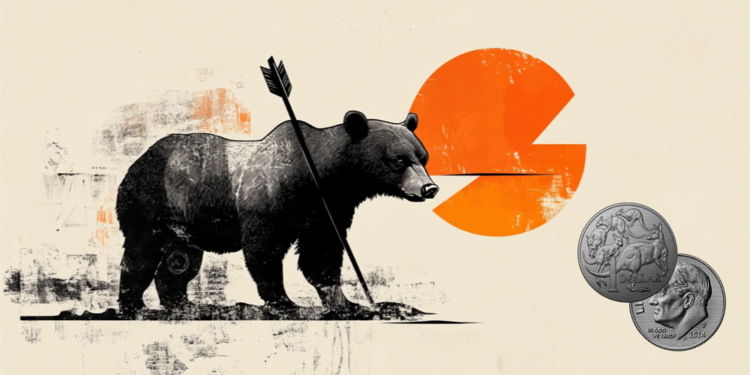With the help of more than five dozen fossils, paleontologists discovered a tiny three -eyed predator nicknamed the “marine moth” that had swim in the Earth oceans 506 million years ago.
Mosura Fentonias the species is known, it belongs to a group called Radiodontes, an initial branch of the evolutionary tree of arthropods, according to a new study published on Tuesday (13) in the magazine Royal Society Open Science.
Although radiodontes are extinct, the study of their fossilized remains can clarify how modern arthropods, such as insects, spiders and crabs, have evolved. One of the most diverse animal groups, it is believed that arthropods represent more than 80% of living animal species, said the main author of the study, Joe Moysiuk, curator of Paleontology and Geology of the Manitoba Museum in Winnipeg.
Well -preserved specimens of the hitherto unknown Mosura Fentoni They also reveal something never seen in any other radiodonte: a body -like body region with 16 segments that include gills at the rear. This part of the creature’s anatomy is similar to a set of segments with breathing organs on the back of the body found in modern relatives distant from radiodontes, such as cornering crabs, garden tatuzinhos and insects, said Moysiuk.
The feature, probably used to help Mosura capture more oxygen from its environment, can represent an example of evolutionary convergence, in which similar structures evolve independently in different groups of organisms, he said.
“The new species emphasizes that these early arthropods were already surprisingly diverse and were adapting in a comparable manner to their distant modern relatives,” said study co-author Dr. Jean-Bernard Caron, curator of invertebrate paleontology at the Royal Ontario Museum in Toronto in a statement.

A unique marine “moth”
No live animals today looks like the Mosura Fentonisaid Moysiuk, although he had articulated claws similar to those of modern insects and crustaceans. But unlike these creatures, which may have two or four additional eyes used to help maintain guidance, Mosura had a third and more conspicuous eye in the middle of the head.
“Although not closely related, Mosura probably swamped similarly to a ray, waving his multiple sets of fins up and down, as if flying under” water, “Mysiuk said by email.” He also had a pencil-shaped mouth and aligned with rows of serial plates, unlike any living animal. “
With the approximate size of an adult’s index finger, Mosura and his fins vaguely resemble a moth, which led the researchers to call him a “marine moth.”
Some of the specimens of Mosura provided intriguing traces of front claws, which helped the radiodonte feed.
Caron used a miniature pneumatic hammer to remove the rock that covered the head of a specimen and found a perfectly stretched spinning claw hidden below, Mysiuk said.
“Unlike many of their relatives who have claws aligned with a mesh of thorns to capture prey, Mosura has long, smooth, fingertips that are forked at the ends,” said Moysiuk said. “It’s a bit enigmatic how exactly he was using it to capture prey, but we think he may have clinging smaller animals with the ends of the thorns and passed them toward his mouth.”

Although there is no direct evidence of what he had eaten him, we know that he lived alongside animals such as shovel worms, polyquette worms and small arthropods similar to crustaceans that the radiodonte could have predicted. In turn, Mosura may have been arrested on other larger radiodontes, such as the Anomalocaris canadiansis similar to shrimp, or gigantic jellyfish Burgessomedusa Phasmiformis. Bicknell was not involved in the new study, but previously was the author of research on Anomalocaris canadiansis.
“This shows that there are even more examples of these animals, specifically ways that were active marine predators, complementing the panorama of how this old marine ecosystem worked,” said Dr. Russell DC Bicknell, postdoctoral researcher at the American Museum of Natural History Paleontology division. Bicknell did not participate in the new study, but has been the author of research on Anomalocaris canadiansis .
The unexpected trunk region of Mosura challenges the researchers ‘understanding of the evolution of the radiodontes’ body and how the group members went from vermiform bodies, Rudy Lurosey-Aubril said, a paleontologist of invertebrates at the Harvard Museum of Comparative Zoology, who was also not involved in the new research.
“This can offer a rare glimpse of development processes, particularly in the early members of the group, before evolutionary changes led to the most consistent body organization seen in most known species,” Lurosey-Aubil said by email.
A fossil treasure
The first specimen of Mosura Fentoni It was discovered at the beginning of the twentieth century by paleontologist Charles Walcott, who was the first person known to collect fossils from Burgess Shale of British Columbia, a fossil bed of 508 million years. Walcott was director of the US Geological Service and administrator of the Smithsonian institution. But no research on the specimen he found was published, and little was known about radiodontes at the time.
The other 60 fossils were collected by researchers from the Royal Museum of Ontario between 1975 and 2022.
“It is only with time and the study of related species that the importance of these fossils gradually became clear,” said Mysiuk. “More recently, our team began finding additional specimens in new Burgess Shale locations in Kootenay National Park, which helped stimulate this publication.”

The fossils found in Burgess Shale, located in Canadian rock mountains, represent a wide variety of animals from the end of the Cambrian period, when life diversified on a large scale. Burgess shale fossils are also known to be incredibly well preserved.
“In this study, we can discern traces of nervous, digestive and circulatory systems, which are almost never preserved as fossils,” Mysiuk said by email. “This provides a unique and significant view of life at this critical moment of earth history.”
The team was able to observe traces that represented beams of nerve in the eye, which – like the modern arthropods – Mosura used for image processing, Caron said.
Instead of arteries and veins, Mosura also had an open circulatory system, meaning that her heart pumping blood to gaps, or large internal cavities of the body. The cavities were preserved as reflective spots within the body.
The discovery of numerous complete and tiny specimens of radiodontes is remarkable, said Lerosey-Aubil. The thin details preserved within the fossil emphasize the importance of Burgess Shale, he added, and a broader image of the complete diversity of Cambrian animals will require the investigation of other places containing fossils and evidence of soft -body organisms.
Radiodonte fossils are permanently exhibited at the exhibition “Dawn of Life” from the Ontario Royal Museum, and a specimen of Mosura will be on display at the Manitoba Museum later this year.
Scientists find first animal capable of surviving without oxygen
This content was originally published in a 506 million year old fossil reveals a small three -eyed predator on the CNN Brazil website.
Source: CNN Brasil
Charles Grill is a tech-savvy writer with over 3 years of experience in the field. He writes on a variety of technology-related topics and has a strong focus on the latest advancements in the industry. He is connected with several online news websites and is currently contributing to a technology-focused platform.







